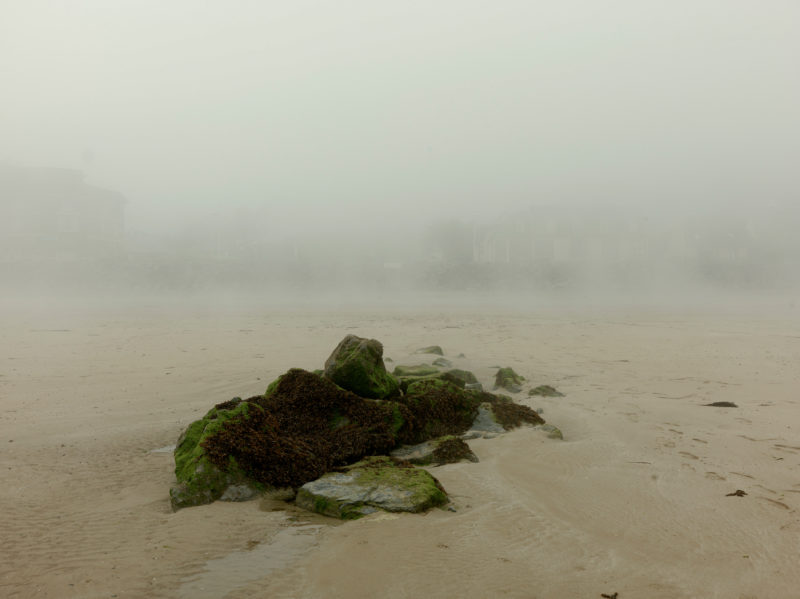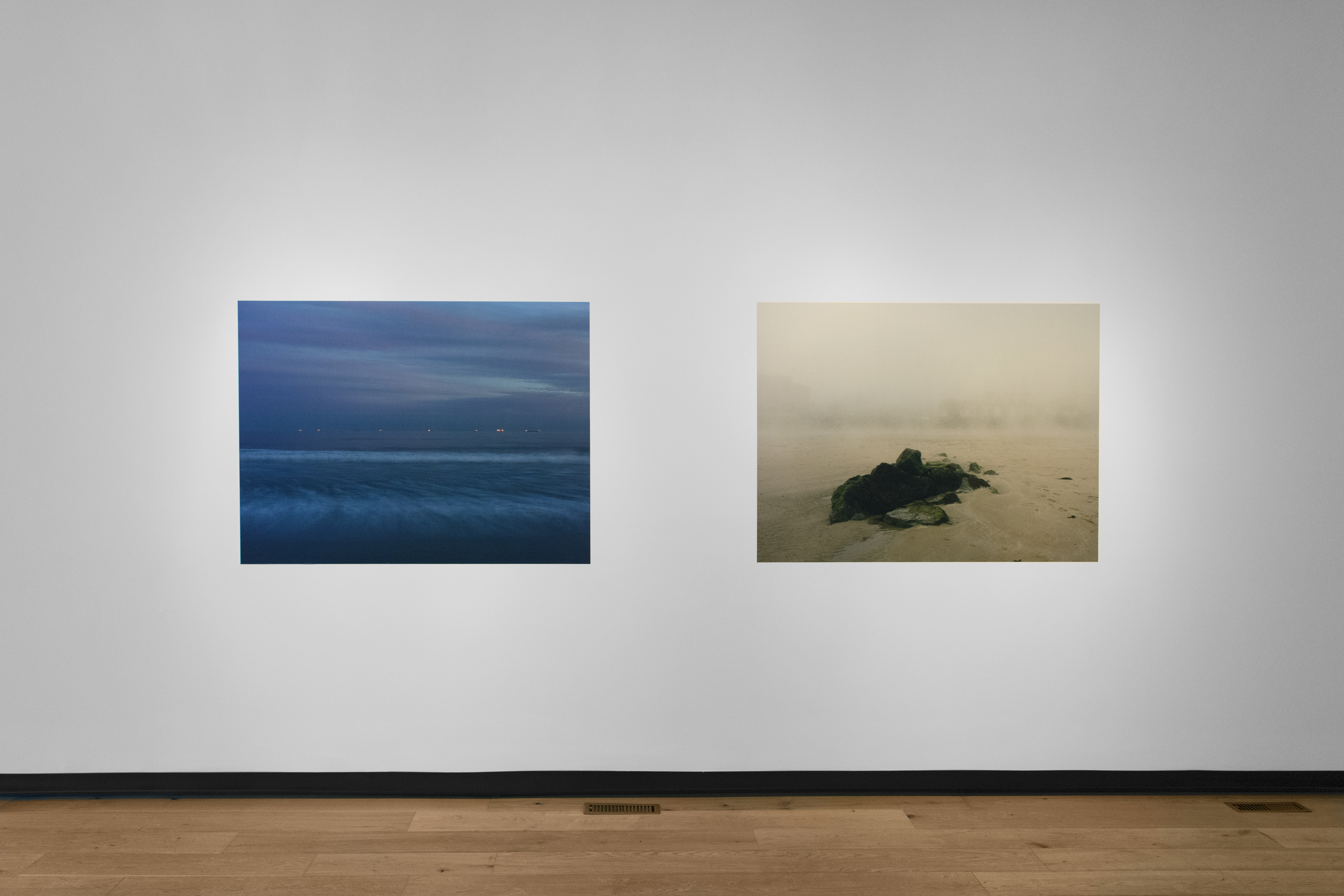MAINSPACE EXHIBITION /

Thomas Kneubühler – Landing Site (East), 2018
Landing Sites
Thomas Kneubühler
February 23–March 23, 2019
Exhibition Description /
With Landing Sites, Thomas Kneubühler looks at the communication cables between Europe and North America, and the change in speed over time. At the centre of the project is the fibre optic cable FLAG Atlantic-1, put in operation in 2001, which connects the US directly with France. It was the first submarine cable able to transmit high quality video. It enabled the internet as we know it today, with all its streaming applications.
Kneubühler went to both landing sites of the FLAG cable, one located in Bretagne, France and the other one in Long Island, New York. The search for signs of the cable turned into an exploration of cultural differences, but also how culture, which is transmitted precisely through this fibre optics cable, becomes interrelated. Before the first telegraph cable was laid down in 1858, it took three weeks for a message to cross the Atlantic by boat. When the first telegraph became available, it took 10 minutes to communicate one single word. In 2001, FLAG Atlantic-1 made it possible to transmit 200 hours of video every second.
The experience of an immigrant in North America is rather different these days with all the communication channels available, which allows you to stay connected with your country of origin; and yet, there are still remote places with no high speed connections, among others, Canada’s far North. Ironically, it’s also a place where mining companies keep looking for precious metals, integral in the production of electronic devices around the globe.
Exhibition Text /
That which is hidden yet carries the world as images
With this series, Thomas Kneubühler continues to render visible institutional structures concealed from public scrutiny, which are at the basis of contemporary power relations. Landing Sites documents the section Atlantic 1 of the Fiber-Optic Link Around the Globe (FLAG-1). This submarine cable runs 14,500 kilometers between Long Island, United States of America, and Plérin, France. Installed in 2000, FLAG-1 is still an important piece of infrastructure connecting Europe to North America. However, it is not the cable itself that is shown in these works, but the sharp tensions it produces across the globe and through time, between different geographies and temporalities.
The diptych Landing Sites (East and West) presents the extremities of the cable in question: two seemingly ordinary maritime sceneries, two sides of the same structure. Only by a sort of mental gymnastics can we keep in mind the thousands of kilometres and the technological exploit this structure bridges. The closeness of the photos in both space and form emphasizes their similarities, reminiscent of the connectedness FLAG-1 was designed to produce. But the meaning of a landscape is constructed as much by what it frames as by what it excludes; the appearance of cohesion at the core of these mysterious pictures only grounds the system of tensions the other works bring forward.
Such periphery of FLAG-1 is distinctly put in view in Ebb and Flow. A video presents children playing in the tundra of Aupaluk, the smallest community in Nunavik, and also one that doesn’t have access to wired Internet connection. This sequence is juxtaposed with another video showing a group of visitors at the landing site in France. The two sites here remind us that resources, such as communications, are not uniformly distributed; instead they are determined by the legacy of colonial land dispossession. Occupied today by mining companies, indigenous territories are now extraction sites for precious metal necessary for the advance of technologies that ancestral inhabitants only marginally benefit from. The children in each video will grow up in very different worlds, each shaped by the lasting impact of this reality.
Nevertheless, those of us who were connected by FLAG-1 saw, in a flash, time and history accelerated. This fiber-optic cable is one of the fastest transatlantic communication to date; it can transmit 200 hours of video in a single second. But how can one begin to imagine such dazzling speed? The video, Transmission, tries to establish an equivalent by condensing 121 films, roughly 200 hours of footage, in a single second. This mesmerizing mural was constituted from the personal film-archive of the artist, which makes it a useful conceptual tool to reflect on the ever-expanding insistence of images accessing our private lives.
In a world of virtual immediacy, we often forget that communication always relies on transport and that not too long ago, their division was indistinguishable. A significant marker in this conceptual decoupling was August 16, 1858, when the first official transatlantic telegraph messages were sent. At the speed of approximately two minutes per letter, it took more than twelve hours to transmit Queen Victoria’s congratulations to President James Buchanan*. Emulating the pace of this technology, the video Announcement, takes seventy-eight minutes to be displayed entirely. With painful slowness for today’s standards, it writes a birth announcement found in a book, reducing commonly used telegraphic phrases to codes, thus saving on the cost of individual letters.
On that account, we notice that the medium works as a metaphor. It not only carries meaning from one location to another, it is the message**. As technologies shape time, space, and human relations around them, they play a significant role on how we relate to one another, but also to oneself. Last Generation situates this exhibition with Kneubühler’s own experience as an immigrant before the ubiquitous Internet we know of today. Resisting the mythical idea of progress, which wants new technology only to provide better ways of doing the same, he observes how different means of communication present not better, but distinctive possibilities to create one’s self.
–Benjamin J. Allard
* Report of the Joint Committee Appointed by the Lords of the Committee of Privy Council for Trade and the Atlantic Telegraph Company, to Inquire Into the Construction of Submarine Telegraph Cables. Eyre and Spottiswoode, 1861. Google Books, https://books.google.ca/books?id=76HmAAAAMAAJ&pg=PA232&redir_esc=y#v=onepage&q&f=false. Accessed 16 January 2018.
** McLuhan, Marshall. Understanding Media: The Extensions of Man. McGraw-Hill Book Company, 1965.





Thomas Kneubühler uses photography, video and installation to examine complex socio-political issues and the limits of representation. His work is based on extensive research, including fieldwork in sometimes remote locations or in places access is restricted. In the process he uncovers unseen links in order to heighten our consciousness about issues often forgotten or suppressed, while not surrendering art’s formal and aesthetic power. Over his career, Kneubühler has explored issues surrounding the privatization of land use, the exploitation of natural resources, questions of power, and the effects of new technology on society.
Born in Solothurn, Switzerland, Thomas Kneubühler has been living in Montreal, Canada since 2000. In 2003, he completed a Master’s degree in Studio Arts at Concordia University, Montreal. His work has been presented in exhibitions and screenings in both Europe and North America, among others at the Centre culturel canadien, Paris, the Centre Pasquart Bienne, the Videonale.15 at the Kunstmuseum Bonn, and at Les Rencontres International in Paris and Berlin. In 2011 he was awarded the Pratt & Whitney Canada Prize of the Conseil des arts de Montréal, and in 2012 the Swiss Art Award by the Ministry of Culture Switzerland.
Benjamin J. Allard is an artist and educator based in Tiohtià:ke (Montréal), unceded Kanien’kehá:ka territory. He is the Cultural Outreach Coordinator at Dazibao, project manager for the Independent Media Arts Alliance, and he produces and hosts atelier on CIBL radio. He completed an MFA in Visual Arts at the University of British Columbia and a BA in Communication Studies at Concordia University. His projects have been exhibited notably at Eastern Bloc (Tiohtià:ke), the Belkin Art Gallery (Vancouver) and published in Inter magazine.
Territorial Acknowledgments
TNG gratefully acknowledges its home on the traditional territories of the people of the Treaty 7 region, including the Blackfoot Confederacy (Kainai, Piikani and Siksika), Métis Nation of Alberta Region III, Stoney Nakoda First Nation (Chiniki, Bearspaw, and Wesley), and Tsuu T’ina First Nation. TNG would also like to acknowledge the many other First Nations, Métis and Inuit who have crossed this land for generations.
